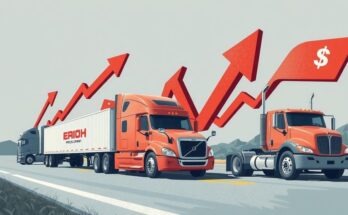Donald Trump is proposing a return to U.S. manufacturing through tariffs aimed at boosting revenue and curbing foreign competition. However, economists warn such measures could lead to increased consumer prices and complicate global trade dynamics, potentially raising inflation without guaranteed benefits to domestic production.
As the countdown to November’s election intensifies, Donald Trump, the Republican presidential hopeful, is pushing a bold vision for America’s economy aimed at rejuvenating U.S. manufacturing and addressing what he perceives as unfair trade practices. His strategy hinges primarily on tariffs, which he believes will not only increase federal revenue but also compel foreign companies to shift their production back onto American soil. “Tariffs, to me, are the most beautiful word,” Trump declared at a Michigan rally, highlighting a controversial approach that could invite unintended consequences. Trump plans to implement tariffs ranging from 10 to 20 percent across the board, with audacious suggestions of up to 200 percent on automobile imports from Mexico. However, while he envisions these tariffs as tools of economic rebirth and retribution against nations like China – whom he accuses of long-term exploitation – economists caution of potential risks looming on the horizon. They raise alarms that such tariffs could trigger heightened consumer prices and disrupt established global trade relationships without necessarily translating into a significant increase in U.S. manufacturing. The reality is that American businesses, contrary to Trump’s assertions, bear the burden of tariffs, which they often pass down to consumers, possibly fueling inflation. The Peterson Institute for International Economics estimates that if Trump’s tariff plan were enacted, inflation could spiral up by 1.3 percentage points. Additionally, economic models suggest that a sweeping tariff could decrease bilateral trade between the U.S. and China by a staggering 70 percent, redirecting the flow of goods and diminishing prospects for the seamless exchange that globalization has facilitated. Trump’s economic proposal also extends to an enhancement of tax cuts for businesses, aiming to invigorate growth. Yet experts from the Tax Foundation express concern that tariff revenues might not effectively offset the tax revenue losses incurred from these cuts. Moreover, the notion of revitalizing U.S. manufacturing is far from straightforward. Many argue that bringing back production capacity to the U.S. isn’t simply about imposing tariffs; it requires rebuilding industries that have languished for decades. Despite his assurances of returning a golden age of manufacturing, market dynamics dictate otherwise. Lack of competitive scale and years of outsourcing have left U.S. factories ill-equipped to meet demand, exacerbating the challenge of reshoring operations. Businesses suffering from escalating input costs often find themselves in a vice, straining to keep prices stable amid rising tariffs. Kyle Handley, an economics professor, warns, “If they do an across-the-board tariff of 10 percent to 20 percent, there’s no way we’re not going to see that on store shelves.” What’s more, Trump’s ambitious plans to cut energy costs and reduce food prices by limiting foreign agricultural imports may trigger retaliatory measures from other countries, to the detriment of American farmers reliant on exports. As this narrative unfolds in the lead-up to the elections, the tension between immediate electoral promises and the complex realities of economic mechanics continues to rise, leaving voters pondering whether the promised land of prosperity is merely a mirage or a deliverable vision.
Donald Trump’s economic strategy for his presidential campaign is centered around revitalizing U.S. manufacturing and using tariffs as a tool to tax imports and press foreign countries to comply with more favorable trade practices. His focus on tariffs reflects a broader nationalist economic strategy that critiques existing trade agreements while aiming to reduce consumer costs through corporate tax cuts. However, economists have voiced concerns that such tariffs could backfire, leading to higher prices for consumers and even retaliatory measures from trading partners.
In summary, Donald Trump’s economic plan intertwined with his tariff proposals aims to accelerate U.S. manufacturing and reduce economic imbalances. However, the complexities of global trade and economic policy raise significant questions about the potential ramifications of such strategies, revealing a delicate balance between ambition and economic sustainability.
Original Source: japantoday.com



